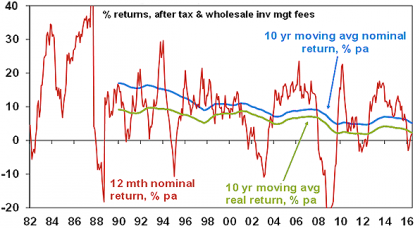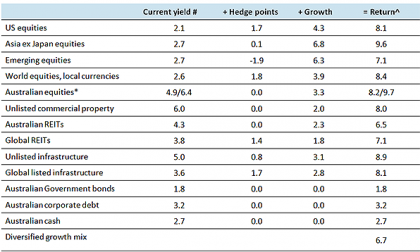While the high inflation of the 1970s and early 1980s was bad for investment returns at the time, it left a legacy of very high investment yields which helped set the scene for high investment returns through the 1980s and 1990s. Back in the early 1980s the RBA’s ‘cash rate’ was averaging around 14%, three-year bank term deposit rates were around 12%, 10-year bond yields were around 13.5%, commercial and residential property yields were running around 8-9% and dividend yields on shares were around 6.5% in Australia and 5% globally. Such yields meant investments were already providing very high cash income. So for assets like property or shares only modest capital growth was necessary to give decent returns. As a result, during this period the medium term (5-10 year) return potential from investing was solid. In fact, most assets had very strong returns in the 1980s and 1990s. Australian superannuation funds saw returns average 14.1% p.a. in nominal terms and 9.4% p.a. in real terms between 1982 and 1999 (after taxes and fees).
Figure 1: Balanced/growth superannuation fund returns

Source: Mercer Investment Consulting, Morningstar, AMP Capital
Since the early 1980s, the starting point in terms of investment yields has been moving progressively lower, resulting in slowing 10-year average nominal and real returns for superannuation funds – this is shown in figure 1. Today, the Reserve Bank of Australia’s cash rate is just 1.5%, three-year bank term deposit rates are just 2.6-3%, 10-year bond yields are just 1.9%, gross residential property yields are around 3% and while dividend yields are still around 6% for Australian shares (with franking credits) they are around 2.5% for global shares.
Projections for medium term returns
Figure 2 presents our projections for medium-term returns across a range of asset classes. Combining the return projections for each asset indicates that the implied return for a diversified growth mix of assets has now fallen to 6.9% p.a.
Several themes are allowed for in our projections: slower growth in household debt; the backlash against economic rationalist policies of globalisation, deregulation and small government; rising geopolitical tensions; aging and slowing populations; low commodity prices; technological innovation and automation; the Asian ascendancy and China’s growing middleclass; rising environmental awareness; and the energy revolution. Most of these are constraining nominal growth and hence investor returns. However, technological innovation is positive for profits may lead to inflation bottoming.
Figure 2: Medium-term (5-7 years) return forecasts

# Current dividend yield for shares, distribution/net rental yields for property and five-year bond yields for bonds. * The Australian dividend yield is net/grossed-up for franking credits
^ Columns may not add precisely to the total due to rounding
Source: AMP Capital
Some assumptions
-
We assume central banks average around or just below their inflation targets, that is, 2.5% in Australia and 2% in the US.
-
For Australia we have adopted a relatively conservative growth assumption below nominal GDP growth potential. This reflects the headwind from weak commodity prices and the impact of this on resource sector profits and sales growth.
-
We allow for forward points in the return projections for global assets based around current market pricing – which adds 1.8% to the return from world equities.
-
The Australian cash rate is assumed to average 2.75% over the medium term. Cash is one asset where the current yield is of no value in assessing the asset’s medium-term return potential because the maturity is so short. As such, we assume a medium-term average. Normally for cash this would be close to a country’s potential nominal growth rate. We have adjusted for higher-than-normal bank lending rates relative to the cash rate and higher household debt-to-income ratios which lowers the neutral cash rate.
In figure 3, we show the projected return for a diversified growth mix of assets. It’s important to note that the medium-term return potential continues to soften largely reflecting the rally in most assets of the last few years. This has pushed investment yields lower. Projected returns for a diversified growth mix of assets has fallen from 10.3% pa at the low point of the Global Financial Crisis in March 2009 to 6.9% now.
Figure 3: Projected medium-term returns for a diversified growth mix of assets, %pa, pre fees & taxes

Source: AMP Capital
Key takeaways
-
The starting point for returns today is far less favourable than when the last secular bull market in shares and bonds started in 1982, due to much lower yields.
-
Government bonds offer low return potential thanks to low bond yields.
-
Unlisted commercial property and infrastructure continue to come out well, reflecting their relatively high yields.
-
Australian shares stack up well on the basis of yield, but it’s still hard to beat Asian shares for growth potential.
-
The downside risks to our medium term return projections are referred to endlessly by financial commentators: namely that the world is plunged into another recession or that investment yields are pushed up to more normal levels causing large capital losses. The upside risks are (always) less obvious but could occur if global growth improves but inflation remains low which could see a continuing search for yield further pushing up capital values.
Implications for investors
There are several implications for investors. First, have reasonable return expectations. The combination of low investment yields and constrained GDP growth indicate it’s not reasonable to expect sustained double-digit returns. In fact, the decline in the rolling 10-year moving average of superannuation fund returns depicted in figure 1 indicates we have been in a lower return world for many years. Second, allow that this partly reflects very low inflation. Real returns haven’t fallen as much and are still reasonable. Third, a dynamic approach to asset allocation may be a way to enhance returns when the return potential from investment markets is constrained. This is likely to be enhanced by continued bouts of volatility. Finally, it’s important to focus on assets providing decent sustainable income as they provide confidence regarding future returns.
Source: AMP Capital
Authors
Dr Shane Oliver, Head of Investment Strategy and Economics and Chief Economist at AMP Capital is responsible for AMP Capital’s diversified investment funds. He also provides economic forecasts and analysis of key variables and issues affecting, or likely to affect, all asset markets.
Diana Mousina
Economist
Important note: While every care has been taken in the preparation of this article, AMP Capital Investors Limited (ABN 59 001 777 591, AFSL 232497) and AMP Capital Funds Management Limited (ABN 15 159 557 721, AFSL 426455) makes no representations or warranties as to the accuracy or completeness of any statement in it including, without limitation, any forecasts. Past performance is not a reliable indicator of future performance. This article has been prepared for the purpose of providing general information, without taking account of any particular investor’s objectives, financial situation or needs. An investor should, before making any investment decisions, consider the appropriateness of the information in this article, and seek professional advice, having regard to the investor’s objectives, financial situation and needs. This article is solely for the use of the party to whom it is provided.



